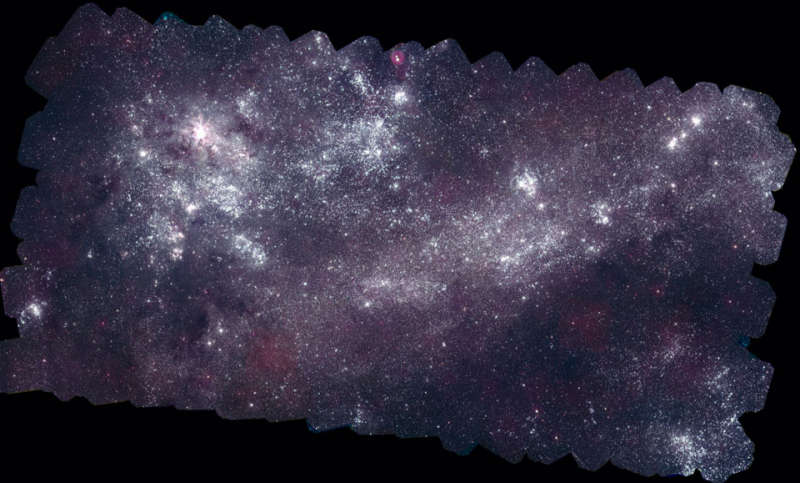Credit & Copyright: UV: NASA,
Swift,
S. Immler (Goddard)
&
M. Siegel
(Penn State);
Optical:
Axel Mellinger
(CMU)
Explanation:
Where are the hottest stars in the nearest galaxies?
To help find out, NASA commissioned its Earth-orbiting Swift satellite to compile
a
multi-image mosaic
of the neighboring
Large Magellanic Cloud (LMC) galaxy in ultraviolet light.
The above image shows where recently formed stars occur in the LMC,
as the most massive of these young stars shine brightly in blue and
ultraviolet.
In contrast, visible in an image
roll-over,
a more familiar view of the LMC in visible light better highlights older stars.
On the upper left is one of the largest star forming regions known in the entire
Local Group of galaxies: the
Tarantula Nebula.
The Large Magellanic Cloud and its smaller companion the
Small Magellanic Cloud are
easily visible with the unaided eye to
sky enthusiasts with a view of the southern sky.
Detailed inspection of the
above image is allowing a better galaxy-comprehensive picture for how
star formation occurs.
1999 2000 2001 2002 2003 2004 2005 2006 2007 2008 2009 2010 2011 2012 2013 2014 2015 2016 2017 2018 2019 2020 2021 2022 2023 2024 2025 |
Yanvar' Fevral' Mart Aprel' Mai Iyun' Iyul' Avgust Sentyabr' Oktyabr' Noyabr' Dekabr' |
NASA Web Site Statements, Warnings, and Disclaimers
NASA Official: Jay Norris. Specific rights apply.
A service of: LHEA at NASA / GSFC
& Michigan Tech. U.
|
Publikacii s klyuchevymi slovami:
LMC - ultraviolet - star formation - BMO - Bol'shoe Magellanovo Oblako - Ul'trafioletovoe izluchenie - zvezdoobrazovanie
Publikacii so slovami: LMC - ultraviolet - star formation - BMO - Bol'shoe Magellanovo Oblako - Ul'trafioletovoe izluchenie - zvezdoobrazovanie | |
Sm. takzhe:
Vse publikacii na tu zhe temu >> | |
